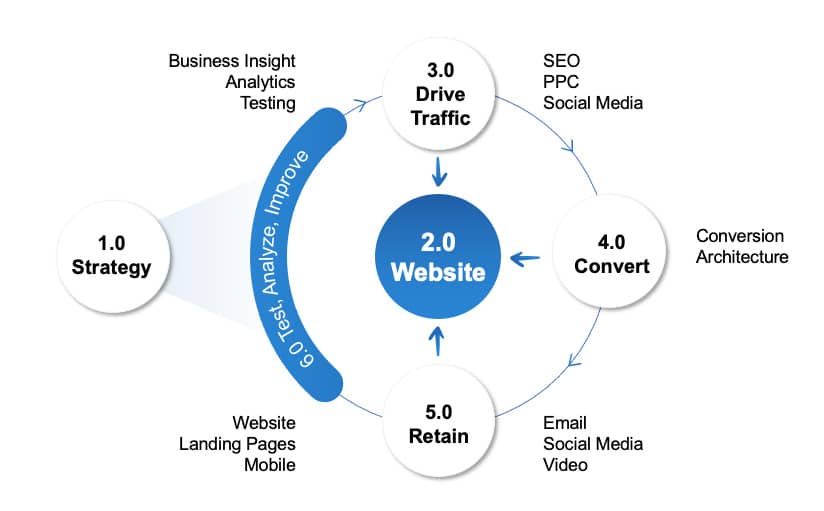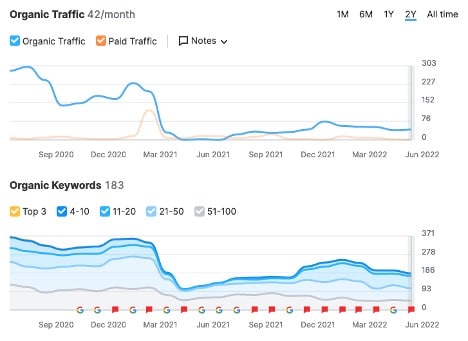5 Vital Digital Marketing KPIs for CEOs & the C-Suite
July 7, 2022
As a leader in your company, you are inundated with numbers. Dashboards, reports, spreadsheets, and analytics are coming from multiple directions day in and day out, reporting on all aspects of your business.
If you do marketing, I can attest there is no shortage of data to distract from the metrics that really matter. Most times when we first meet with a prospective client, they reference metrics and stats that are the wrong ones for them to be paying attention to. We still hear ‘hits’ every once in a while.
For digital marketing and the sophisticated tools and technologies that are in use, we are perpetually collecting data to better understand how our prospects are interacting with our brand online, and how to improve conversion rates and engagement.
Most of that data is vital for us in the trenches, working on making campaigns and marketing initiatives perform better, but not for the C-level suite.
Here are the 5 key digital marketing metrics to watch as a CEO or director.
Sales/Dollars Generated from Digital Marketing
Clearly, this should be the number one metric we should be working towards, GROWTH. Most of our clients see 200+% hard ROI directly from our campaigns.
Getting an accurate number for this KPI can be difficult for two reasons:
- It takes full end-to-end reporting-This usually requires a CRM and marketing automation platform, along with a disciplined sales team with some level of business processes in place.
- We live in multi-touch age-There is a wide array of marketing tactics and strategies in place to help grow your business. A user may see a social post, read a blog, see a display ad, all before converting. Not to mention traditional media in place that is sending users online, from industry magazines to trade shows.
The other big consideration for this metric is the SOFT ROI.
100% of your customers visited your website before doing business with you, and nearly 85% visited your website, or interacted with your brand before calling or beginning the conversation.
So, although you met at a tradeshow, and your top sales person did everything right, that person, or their boss, or their team interacted with your online presence before the deal was closed.
Opportunities Created – Meaningful Conversations
For most, ‘opportunities created’ is the driving metric under direct revenue. More opportunities typically indicate more revenue no matter the size of your company or sales staff.
This is an important metric to watch, as it helps define the quality of incoming leads. If opportunities are being created against leads deriving from digital efforts, then we know we are targeting the right prospects.
As a marketer, this can be helpful to fine tune our efforts, or expand efforts where we are seeing success.
Raw Leads – Fill the Funnel
In our sales funnel, we need to keep the top full of new incoming leads. We use the term ‘raw leads’ because leads coming in from the digital channels are typically colder in nature.
The relationship is just starting, they just met you from a Google search. They will need more information on your brand/product. They need time to develop that relationship and trust you to do business with you.
This KPI does not always need be a huge number. One manufacturer needed 2 qualified leads a month to fit into their growth strategy.
Website Traffic – You Need Visitors
In the above graphic, we have our philosophy on what it takes to run successful digital campaigns, and TRAFFIC IS STILL VITAL.
Paying attention to traffic can also provide insight into the effectiveness of other marketing efforts. For example:
- Did we get a bump after a tradeshow sponsorship?
- We’re exploring social media, is it driving visits back to our site?
- New videos on the site, are customers engaging?
Google Analytics has thousands of datapoints to pull from, and some are more important than others, but as a leader in your company, make sure traffic is steady or increasing.
I won’t argue, all traffic is not created equal (low traffic by highly qualified users is also valuable), but if you are investing in search engine optimization, then you should be gaining exposure, rankings and traffic.
Overlooking this metric can have serious implications for businesses. Take this research we recently did for a prospect: new website launched, rankings & traffic tanked. I suspect they had a dated website with lots of pages (which is GREAT for SEO), and during modernizing, and simplifying, they condensed pages and removed content.
Content Production
Content is King, still.
For most of our clients, content development and production are very difficult:
- They’re not large enough to have a full marketing/content team
- Tasked to someone that already has a full plate
- Challenging to ‘extract’ information from the operations/technical teams
- Easy to drop to bottom of the to-do list as it’s not critical
This metric should be a simple target of what and how you are communicating with your community and potential prospects.
The benefits of a consistent quality content feed are HUGE:
- Can offer value-added information to potential customers
- Gain trust and tell stories of your successes
- Still a vital piece of SEO
- Adds meaningful and original content to your social media activity
Here are some easy examples of goals we’ve used with clients:
- 3 blog posts per month
- In-depth guide per quarter
- 1 video testimonial per month
- 1 case study per month
If you are not producing content and leading the conversation in your industry, then your competition is.
Let’s Discuss Your KPIs
The KPIs above should be top of your list, but each business is unique and has their own challenges when it comes to digital marketing.
Let’s review the competitive landscape for your company and start to identify what should be mattering to YOU.







